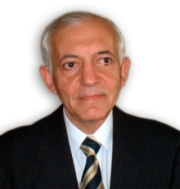| Submission Procedure |
Combinatorics and Related Areas |
|||||||||||||||
| His talent for mathematics was evident from his highschool years when he won the second and first prize of the Romanian Mathematics Olympiads in 1959 and 1960. Later on, he was awarded the "Applied Mathematics Prize" at the First Balkan Mathematics Competition for Students and Young Researchers (1971) and the "Gheorghe Ţiţeica Prize" of the Romanian Academy (1975). Professor Tomescu was the leader of the Romanian team for the International Olympiad in Mathematics (1983-1986 and 1990-1994) and the leader of the Romanian team for the "Balkan Olympiad in Mathematics" (1990-1994). |  |
Professor Tomescu's areas of research are combinatorics and graph theory and applications. He has obtained his PhD in Mathematics in 1971 with the Thesis "Combinatorial Methods in the Theory of Finite Automata" under the supervision of Academician Gr. C. Moisil.
In his thesis, he proposed a matrix method for determining all pairs of compatible states of a sequential Mealy machine and showed that the minimisation of such a machine can be reduced, in some case, to the problem of finding a minimum chromatic partition of the vertex set of a graph. During a prolific research career which continues unabated to this day, Professor Tomescu has made important contributions in the theory of combinational circuits, extremal graph theory (especially in problems related to vertex colourings and chromatic polynomials), hypergraphs and their connection to Bonferroni-type inequalities, Hamiltonian problems for some classes of graphs, combinatorial chemistry, combinatorics on words, metric graph theory.
Professor Tomescu has published more than 140 papers in various peerreviewed journals (including Discrete Mathematics, Discrete Applied Mathematics, Theoretical Computer Science, Combinatorica, Journal of Prime Research in Mathematics, Australasian Journal of Combinatorics, J. Graph Theory, Journal of Combinatorics, Quart. J. Math. Oxford, Journal of Integer Sequences, Journal of Combinatorial Theory Series B, Journal of Universal Computer Science, Europ. J. Combinatorics, Ars Combinatoria, Random Structures and Algorithms, Comm. Math. Chem., Pattern Recognition Letters, Computer Vision, Graphics, and Image Processing, RAIRO, Rev. Roumaine Math. Pures Appl., etc.). He also published many papers, notes, and problems in the Romanian journal "Gazeta Matematică" (http://www.gazetamatematica.net), founded in 1895, one of the oldest mathematics journals for high-school students and teachers.
His book Introduction to Combinatorics (first published in Romanian by Ed. Tehnică, Bucharest, 1972, 250 pp., later translated into English ᾰ published by Colette's, London and Wellingborough, 1975, 249 pp. — and in Hungarian — published by Müszaki Könyvkiado, Budapest, 1978, 270 pp.) has been very influential. Another very well-known book is his Problems in Combinatorics and Graph Theory, J. Wiley, 1985, 335 pp. He also published 14 other books in graph theory, combinatorics, applied mathematics, data structures, and problems for Mathematical Olympiads.
Professor Tomescu's results have been quoted by numerous mathematicians and computer scientists, including C. Berge, A. Zykov, A. Korshunov, E. Palmer, F. Harary, R. Robinson, E. Shamir, F. Rhodes, R. Melter, P. Hansen, J. Akiyama, V. Chvátal, V. Iliev, F. Zitek, T. Saaty, P. Kainen, F. Lazebnik, K. Koh, C. Teo, H. Meyniel, M. Golumbic, J. C. Bermond, D. Sotteau, H. J. Voss, Y. Wakabayashi, R. Steinberg, J. Galambos, J. Bukszár, F. M. Hoppe, D. A. Grable, S. Kounias, K. Dohmen, D. Q. Naiman, H. P. Wynn, F. M. Hoppe, D. R. Hoover, Y. H. Peng, F. M. Dong, C. H. C. Little, G. L. Chia, I. M. Gessel, O. D. Byer, J. Nieminen, V. Chepoi, H. J. Bandelt, M. Deza, I. Rosenberg, P. Dankelmann, H. C. Swart, D. B. West, M. Zheng, A. Kaufmann, E. Pichat, R. Entringer, B. Liu, B. Laskar, M. Randic, I. Gutman, B. N. Cyvin, S. Klavzar, G. S. Fridman, B. Monjardet, J. P. Barthélemy, B. Leclerc, T. Sozanski, W. Brauer, M. Gondran, M. Minoux, B. Roy, B. A. Carré, P. L. Hammer, S. Rudeanu, C. F. Picard, N. Deo, E. A. Bender, E. R. Canfield, M. Borowiecki, E. Lazuka, R. J. Gould, A. V. Kostochka, D. R. Woodall, C. Chen, M. S. Klamkin, P. M. Pardalos, L. C. Hsu, J. E. Nymann, A. Z. Mekjian, C. M. Campbell, R. M. Thomas, M. Dale, P. E. John, J. V. Knopp, K. Szymanski, D. Defays, W. He, S. Xie, Sherif El-Basil.
Professor Tomescu has a quiet and charming personality. His influence, through research and teaching, is impressive. A glimpse of it can be seen by reading the papers in this special issue. Everybody who had the chance to work with him was marked by his deep ideas, his mathematical knowledge and abilities. This is true for all collaborators to this volume who wish him A Very Happy Birthday!